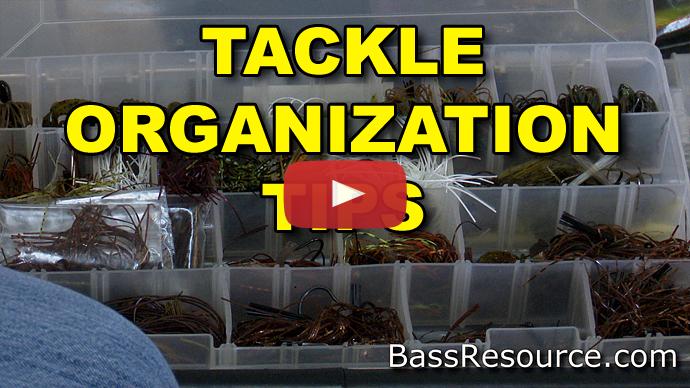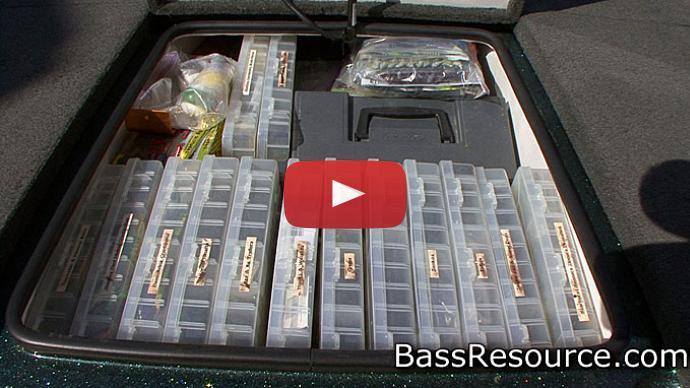Keri: Hey, there he goes again. There he goes again. You have a nice little largemouth. It's a little bigger one.
Glenn: Here you go.
Keri: Bigger largemouth?
Glenn: Yep. He's feeding.
Keri: Yep, trying to get fat.
Glenn: They’ll get bigger.
Keri: They will. They will.
Glenn: Hey, folks. Glenn May here with BassResource.com. And today I want to talk to you about tackle organization, and how that affects your success on the water and some of the techniques and tactics that you need to do in order to be more successful on the water. Let's kind of dive into that.
Let me start off with this. I think the methodology that I'm about to give you and tell you about, I honestly think that bank fishermen, kayak fishermen, and back seaters have a distinct advantage over boaters when it comes to this. And we'll get into that in a minute, but I really think that boaters kind of gloss over this stuff that I'm about to tell you about. And it bites them in the butt. Eventually, it does. So I'm going to tell you about it and hopefully, it helps you too.
So the first thing you want to do when you're getting ready for a day in the lake, whether it's a tournament or it's just a fun day of fishing, take all your rods and reels out and lay them out. I don't care how many they are, but lay them out. Take a look at them. You've probably got a pretty good idea in your mind how that day is going to go on your day of fishing. What fish are going to be biting, where are you going to be fishing, and what kind of cover or structure they're going to be on. So you've got an idea of what kind of lures you should be using.
Do you have those tied on? Great. Cut them off, retie them. It's the first thing you want to do. Check your line, cut them off, put new knots on them, check your hooks, sharpen them and make sure that those rods and reels are ready to go out of the gate. You've got those set up.
Now, think to yourself, "What if those fish aren't doing what I think they're going to be doing? Then what? What am I going to do? What if the day isn't going to go exactly the way I have it thought out in my mind? What am I going to do to adjust?" That's your plan B.
Look at your rods and reels. Re-rig accordingly. You know, maybe you've got three rods and reels already rigged for Plan A. Now you pick three or four rods and reels for Plan B, rig those up. Now you're ready to go.
And keep going down the line. What if plan B doesn't work out? What are you going to do for Plan C? What are you going to do for plan D? Just depends on how many rods and reels you have. The more you have, the more plans you can lay out. Obviously, if you only have five rods, you can maybe only do Plan A and B. But that's good. That's really good.
You want to do that. Because what this does is it, kind of, mentally prepares you for the day of fishing. You start thinking through, like, what are you going to do? Where are you going to fish? How are you going to do it, and when the day starts off? And if things change, conditions change, the fish move or things aren't working out the way they were going to be...you think are, you already have it figured out. What are you going to do next? What's your decision going to be? You're not going to sit there on the water going, "I don't know. I don't know what to do, man. The fish aren't biting like I thought they were. I don't know where they are." Right? That's not going to happen. You already have it in your mind what you're going to do.
Not only that, but you're rigged, ready to go. You're set. Okay, you don't have to re-tie, re-rig, reconfigure...change your mental attitude. You're done. It's just a matter of shifting locations, grabbing the next rod and reel, and you're off and going again. No hesitation. That's a big confidence builder right there. Knowing that you're prepared, both mentally and with all your equipment. You know that you're all set to adapt to any changing conditions or if things don't go your way, you have a game plan in mind. That's really important, getting that setup.
Glenn: Here we go.
Keri: Here we go.
Glenn: Where was he, just cruising?
Keri: Just cruising, sitting right there and I just threw it right on top of him. And he went, "I think I'll eat that." Yeah, he says, "I think I'll eat that." Little buck bass.
Glenn: That works.
Keri: They're cute. They're fun to catch.
Glenn: The next piece of it is when you are setting up all your equipment, all your tackle, and you're going through it and you're organizing it and you're re-rigging, what I do is get organized...I may reorganize my tackle in those game plans. So my tackle, I've got tackle for game plan A, tackle for game plan B, tackle for game plan C. I got an idea where those are, and I may rearrange things to fit those scenarios. That way, I've got it figured out. When I need to flip to B, I've got tackle already lined up, ready to go, and I know where it is. It's set. I'm organized. I'm all set.
Not only that but as you go through the tackle, you can check inventory. And you can tell, like, how much do I have? For example, this is what happens. A lot of boaters do this. You know, you can carry a small tackle store in your boat. And a lot of times what happens is you get your favorite baits that you rely on, you go out there and you're fishing on the first day of a tournament or maybe a fun day of fishing, and halfway through that day you've burned through your favorite plastic bait and you don't have any more left. Now you're stuck. If you're at a tournament, you're relying upon the local tackle store having what you want in stock. That may or may not happen.
And so that's a big blow to your confidence if you need to fish the next day, not using your favorite baits. So looking at your tackle while you're re-rigging gives you a chance to look at your inventory and replenish as necessary so you know that you've got plenty of what you need for your day of fishing, fun fishing, or whether you're in a tournament. You don't have to worry about running out.
Keri: There you go. It's holy Toledo. That's a good one.
Glenn: Yeah.
Keri: Come on, turn on.
Glenn: Here we go.
Keri: Big old hole in his mouth.
Glenn: Boy, that hook just.
Keri: Bet it was bigger than that. Nice one though. Another RageBug
Glenn: Nice. That'll work.
Keri: That'll work.
Glenn: Thank you, buddy.
Keri: He stole your bug too. He's gone.
Glenn: Now, when you put all the stuff away, when you've already rigged all the stuff, I like to put it away in reverse order. Plan D first, plan C next, plan B. That way the rods and reels that I don't think I'm going to really need, those are at the bottom of my rod lockers and the ones that I'm going to use first thing out of the gate, I've got them on the very top, ready to go. I pull them out and I'm fishing. So I know where everything is.
That's really important when you're on the water because it does two things. First of all, it makes you very, very efficient. You know where everything is. It's all within reach especially your primary stuff. Your primary tackles is in your A-game. Your rods and reels are in your A-game. It's readily available. You know where it's at. So you're efficient. You can get to it right away.
But also, now that you've gone through everything, you know where everything is located in your tackle and gear. Whether you're, again, you're a bank fisherman, or whether you're a boater, you know where it's all at.
Too many times...have you guys seen this with a boater? He wants a specific rod or a specific lure, or he's... "You know, I'm sure I have that tied on somewhere." Next thing you know, he's got all those rod compartments open and his head buried inside of his compartments looking for something. And he's pulling everything out digging through it, trying to find stuff.
You know, pros do this too. I know of a pro, this guy, he uses duffel bags for soft plastics. And he thinks that that keeps them organized because he knows duffel bags and he's got them somewhat organized. But I've seen him open a duffel bag and he's...the bags are all loose, and he's digging through everything trying to find stuff. You know, when you're doing that you get frustrated. You get flustered. You're sucking up time when you're on the water. It throws you off your game, and it eats away at your confidence.
So, knowing where everything is...this is why I say bank fisherman, kayak fisherman, back seaters are a little better at this because they have to consolidate their gear. They have to be very concise on what they bring and know where all that is because they have limited space and limited capacity to carry everything. So they're much more organized when it comes to this. Boaters, they just stuff it on their boat and go, "I know I got it somewhere," and it bites them. Or they find out that they don't have it when they thought they did. That's another thing.
So, doing all these things really helps you be a lot better on the water. It helps you catch a lot more fish. I hope those tips help. For more tips and tricks like this, visit BassResource.com.



